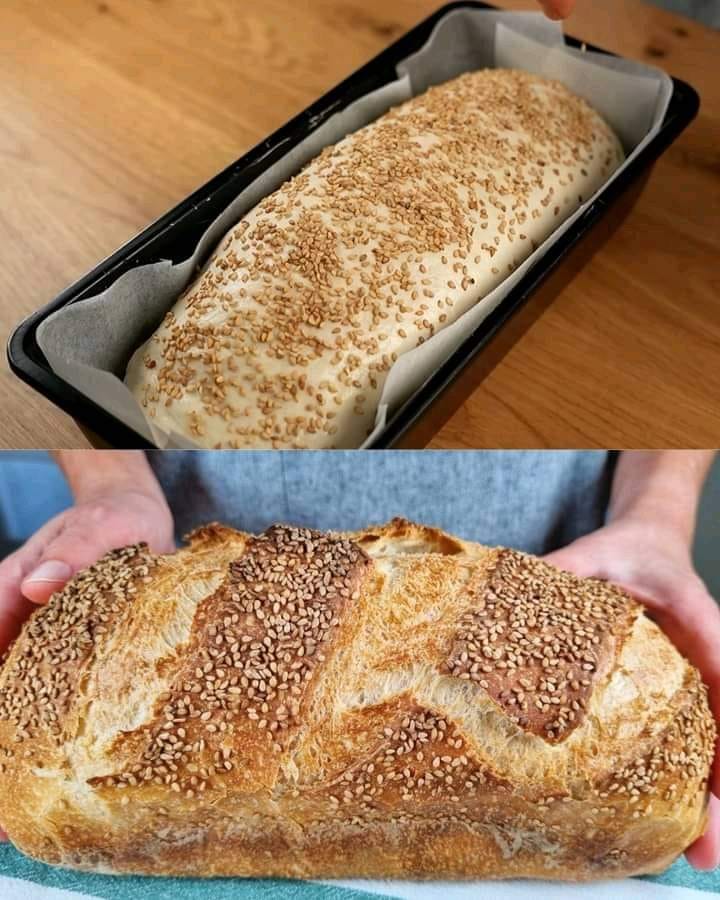Directions:
- In a bowl, mix the water, yogurt, yeast, and a pinch of sugar to activate the yeast.
- Add the vegetable oil, flour, and salt to the wet mixture. Stir until all the dry flour is incorporated—no need to knead.
- Cover the dough and let it rest for 30 minutes.
- After resting, wet your hands and stretch the four sides of the dough, folding each side toward the center.
- Using the “lift and slap” technique, lift the dough and slap it back into the bowl. Cover and let it rest for another 30 minutes.
- Once the dough has risen, sprinkle some flour on your work surface, fold the dough in half, and gently flatten it into a rectangle.
- Repeat the stretching, folding, and lifting process one more time. After this second round, let the dough rise until doubled in size, about 2 hours.
- Roll the dough and press down with your fingers to seal the edge. Pinch the seams to close it well.
- Move the dough into a loaf pan lined with baking paper. Cover with a towel and let it rise for another 30 minutes.
- Preheat the oven to 430°F (220°C).
- Once the dough has risen, brush the top with water and sprinkle sesame seeds or other seeds of choice.
- Score the top of the bread with a sharp blade.
- Remove the top loaf pan and bake for another 10 minutes to crisp up the crust.
- Cover the loaf pan with another loaf pan and bake for 25 minutes.
- Remove the bread from the pan, cover it with a towel, and let it cool completely before slicing.
Serving Suggestions:
- Spread with butter or jam for a simple, delicious snack.
- Use this bread to make gourmet sandwiches, or as toast for breakfast with avocado.
- Pair it with soups or salads for a light meal.
Cooking Tips:
- Make sure your yeast is fresh for the best rise.
- You can add herbs like rosemary or garlic to the dough for extra flavor.
- To avoid the dough sticking to your hands, keep them slightly wet while working with it.
Nutritional Benefits:
- Minimal added sugar and oil make this bread a healthier option compared to store-bought alternatives.
- Yogurt in the dough adds protein and calcium, enhancing the bread’s nutritional value.
- Rich in complex carbohydrates, providing sustained energy.
Dietary Information:
- This bread is vegetarian-friendly.
- Free from preservatives and artificial additives, making it a wholesome choice.
- Can be made dairy-free by substituting the yogurt with a plant-based option.
Nutritional Facts (per slice, based on 12 slices):
- Calories: 130 kcal
- Carbohydrates: 22g
- Protein: 4g
- Fat: 3g
- Fiber: 1g
- Sodium: 170mg
Storage:
- Freeze for up to 1 month. Thaw at room temperature or reheat in the oven to restore crispiness.
- Store at room temperature in an airtight container for up to 3 days.
Why You’ll Love This Recipe:
- The crust is thin and crispy, while the inside remains soft and pillowy.
- It’s free of additives, delivering a healthier, homemade alternative to store-bought bread.
- The recipe is straightforward, requiring no kneading, making it great for beginner bakers.
- The versatility of this bread makes it perfect for sandwiches, toast, or just enjoying with butter.
Conclusion:
This super soft and crispy bread will make your kitchen smell like a bakery and your taste buds dance with delight. Its simplicity in preparation and impressive results will make it a staple in your household. With no preservatives, it’s a wholesome, healthier choice for you and your family. Make this once, and it’ll quickly become a go-to recipe for all your bread needs!
Frequently Asked Questions (FAQs):
- Can I make this bread gluten-free?
Yes, use a 1:1 gluten-free flour substitute specifically for bread. - Can I use instant yeast instead of fresh or dry yeast?
Yes, you can substitute with the same amount of instant yeast. - What if my dough doesn’t rise?
Ensure the yeast is active by testing it in warm water with sugar before mixing. - Can I make the dough in advance?
Yes, you can refrigerate the dough after the first rise and bake it the next day. - Can I use whole wheat flour instead of bread flour?
Yes, but the bread will be denser. You can use half whole wheat and half bread flour for a lighter loaf. - Why do I need to cover the loaf pan during baking?
Covering traps steam, creating a crispy crust while keeping the inside soft. - How do I know the bread is fully baked?
It should sound hollow when tapped on the bottom, and the internal temperature should be 190°F (88°C). - Can I add other ingredients to the dough?
Yes, you can mix in seeds, nuts, or dried fruits for added texture and flavor. - Can I make rolls instead of a loaf?
Absolutely! Simply divide the dough into smaller portions and adjust the baking time. - What if I don’t have a loaf pan?
You can shape the dough into a free-form loaf and bake it on a parchment-lined baking sheet.
ENJOY!!!
Pages: 1 2

